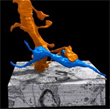Saturday, 18 July 2015
Microscopic Synapses and Giant Microscopes

More and more courses are being offered for free online by prestigious universities. Many of these courses deal with various aspects of the cognitive sciences. One such course is “The Fundamentals of Neuroscience”, from Harvard University (see first link below). This course includes various multimedia features, including an excellent 30-minute documentary video entitled “Connectomics: Big Microscopes & Tiny Synapses” (second link below). This video presents the research being done by Professor Jeff Lichtman and his colleagues in his laboratory, who are using images of real human brains to try to map the connections between their neurons—the synapses.
Stated like that, the idea doesn’t sound so complicated. But when you consider that, as Lichtman says, there are as many synapses in the human brain as there were petabytes of digital content on the planet as of 2014, then you understand his little grin when he says “That’s the problem!” As he puts it differently a little later in the video, there is about one synapse in every three-quarters of a cubic micron in the brain. Hence, in a piece of brain tissue the size of a grain of salt (about 400 microns by 400 microns by 400 microns), there are over 64 million synapses. And just think about how many grains of salt it would take to equal the volume of a human brain!
You can thus better understand the contagious enthusiasm of Lichtman and especially of his colleague Bobby Kasthuri when they explain their approach, which uses 3D reconstructions of 2D images captured with an electron microscope at a resolution that shows the complexity of the synapses in all their detail. You may even feel nervous along with them as they bring into their laboratory a new electronic microscope that has 61 beams instead of just one and so is 61 times faster and more powerful than the one they had before.
As Lichtman says, by literally immersing themselves in this complexity, he and his team have begun to understand the unbelievably complex “kluge” by which evolution, keeping whatever works and discarding whatever does not, has wired the connections of the human brain. This immersive approach is starting to be called “connectonomics” in English and is similar to that of Sebastian Seung and his “EyeWire” project. As Lichtman points out, it is also not unlike that of Darwin, who spent years immersing himself in the diversity of living forms before he could imagine his ideas on evolution by natural selection.
Lichtman also recalls that the scientists of his generation lived through an era when many grand theoretical concepts about the brain emerged, because so few empirical data were available. It was only later that researchers began to look for empirical confirmation of these grand theories. But according to Lichtman, now that we are in an era where “big data” can be captured and analyzed with powerful tools such as 61-beam electron microscopes and massively parallel computing, inference has become the most promising approach once again.
Lichtman ends his talk on an “optimistic ”note, pointing out that old scientists like him will eventually die and younger scientists, who have always been immersed in big data without being blinkered by preconceived theories, may then be able to infer grand principles to help us better understand the complexity of the neural connections that underlies the complexity of human behaviour.
![]() The Fundamentals of Neuroscience
The Fundamentals of Neuroscience
![]() Connectomics: Big Microscopes & Tiny Synapses
Connectomics: Big Microscopes & Tiny Synapses
From the Simple to the Complex | Comments Closed








